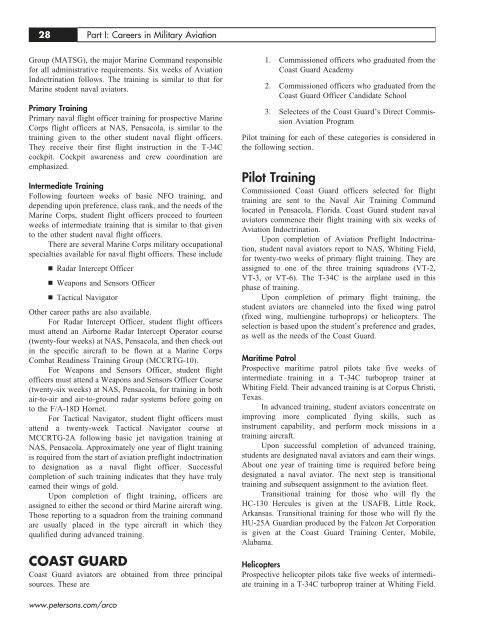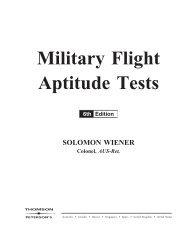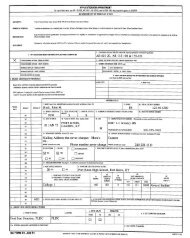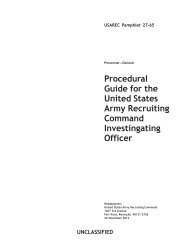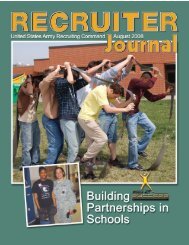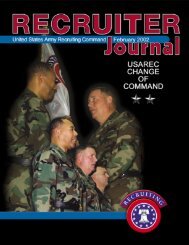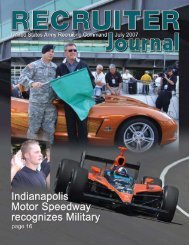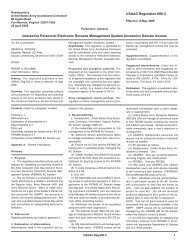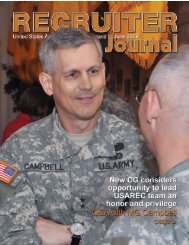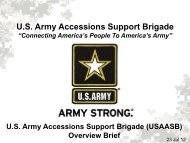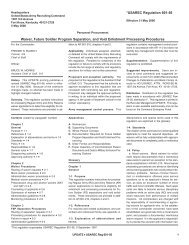Military Flight Aptitude Tests - USAREC - U.S. Army
Military Flight Aptitude Tests - USAREC - U.S. Army
Military Flight Aptitude Tests - USAREC - U.S. Army
You also want an ePaper? Increase the reach of your titles
YUMPU automatically turns print PDFs into web optimized ePapers that Google loves.
28 Part I: Careers in <strong>Military</strong> Aviation<br />
Group (MATSG), the major Marine Command responsible<br />
for all administrative requirements. Six weeks of Aviation<br />
Indoctrination follows. The training is similar to that for<br />
Marine student naval aviators.<br />
Primary Training<br />
Primary naval flight officer training for prospective Marine<br />
Corps flight officers at NAS, Pensacola, is similar to the<br />
training given to the other student naval flight officers.<br />
They receive their first flight instruction in the T-34C<br />
cockpit. Cockpit awareness and crew coordination are<br />
emphasized.<br />
Intermediate Training<br />
Following fourteen weeks of basic NFO training, and<br />
depending upon preference, class rank, and the needs of the<br />
Marine Corps, student flight officers proceed to fourteen<br />
weeks of intermediate training that is similar to that given<br />
to the other student naval flight officers.<br />
There are several Marine Corps military occupational<br />
specialties available for naval flight officers. These include<br />
n Radar Intercept Officer<br />
n Weapons and Sensors Officer<br />
n Tactical Navigator<br />
Other career paths are also available.<br />
For Radar Intercept Officer, student flight officers<br />
must attend an Airborne Radar Intercept Operator course<br />
(twenty-four weeks) at NAS, Pensacola, and then check out<br />
in the specific aircraft to be flown at a Marine Corps<br />
Combat Readiness Training Group (MCCRTG-10).<br />
For Weapons and Sensors Officer, student flight<br />
officers must attend a Weapons and Sensors Officer Course<br />
(twenty-six weeks) at NAS, Pensacola, for training in both<br />
air-to-air and air-to-ground radar systems before going on<br />
to the F/A-18D Hornet.<br />
For Tactical Navigator, student flight officers must<br />
attend a twenty-week Tactical Navigator course at<br />
MCCRTG-2A following basic jet navigation training at<br />
NAS, Pensacola. Approximately one year of flight training<br />
is required from the start of aviation preflight indoctrination<br />
to designation as a naval flight officer. Successful<br />
completion of such training indicates that they have truly<br />
earned their wings of gold.<br />
Upon completion of flight training, officers are<br />
assigned to either the second or third Marine aircraft wing.<br />
Those reporting to a squadron from the training command<br />
are usually placed in the type aircraft in which they<br />
qualified during advanced training.<br />
COAST GUARD<br />
Coast Guard aviators are obtained from three principal<br />
sources. These are<br />
www.petersons.com/arco<br />
1. Commissioned officers who graduated from the<br />
Coast Guard Academy<br />
2. Commissioned officers who graduated from the<br />
Coast Guard Officer Candidate School<br />
3. Selectees of the Coast Guard’s Direct Commission<br />
Aviation Program<br />
Pilot training for each of these categories is considered in<br />
the following section.<br />
Pilot Training<br />
Commissioned Coast Guard officers selected for flight<br />
training are sent to the Naval Air Training Command<br />
located in Pensacola, Florida. Coast Guard student naval<br />
aviators commence their flight training with six weeks of<br />
Aviation Indoctrination.<br />
Upon completion of Aviation Preflight Indoctrination,<br />
student naval aviators report to NAS, Whiting Field,<br />
for twenty-two weeks of primary flight training. They are<br />
assigned to one of the three training squadrons (VT-2,<br />
VT-3, or VT-6). The T-34C is the airplane used in this<br />
phase of training.<br />
Upon completion of primary flight training, the<br />
student aviators are channeled into the fixed wing patrol<br />
(fixed wing, multiengine turboprops) or helicopters. The<br />
selection is based upon the student’s preference and grades,<br />
as well as the needs of the Coast Guard.<br />
Maritime Patrol<br />
Prospective maritime patrol pilots take five weeks of<br />
intermediate training in a T-34C turboprop trainer at<br />
Whiting Field. Their advanced training is at Corpus Christi,<br />
Texas.<br />
In advanced training, student aviators concentrate on<br />
improving more complicated flying skills, such as<br />
instrument capability, and perform mock missions in a<br />
training aircraft.<br />
Upon successful completion of advanced training,<br />
students are designated naval aviators and earn their wings.<br />
About one year of training time is required before being<br />
designated a naval aviator. The next step is transitional<br />
training and subsequent assignment to the aviation fleet.<br />
Transitional training for those who will fly the<br />
HC-130 Hercules is given at the USAFB, Little Rock,<br />
Arkansas. Transitional training for those who will fly the<br />
HU-25A Guardian produced by the Falcon Jet Corporation<br />
is given at the Coast Guard Training Center, Mobile,<br />
Alabama.<br />
Helicopters<br />
Prospective helicopter pilots take five weeks of intermediate<br />
training in a T-34C turboprop trainer at Whiting Field.


